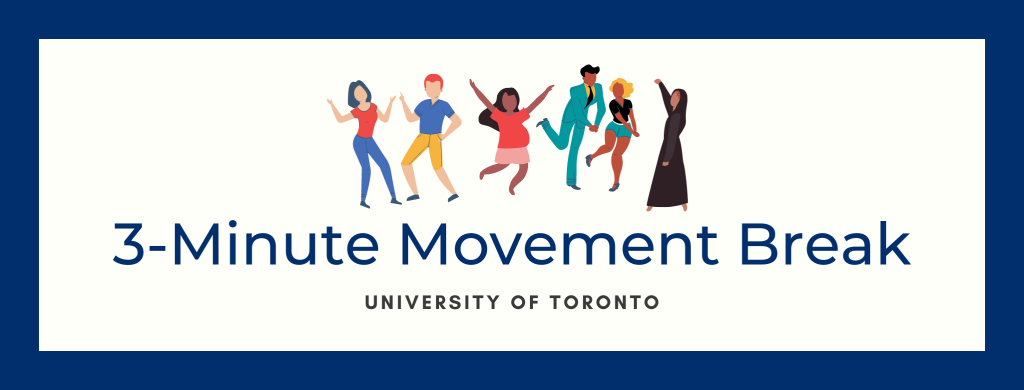
| HOME | ABOUT | VIDEOS | RESOURCES | CONTACT | TESTIMONIALS | ||||
Message from the team
The Movement Break Resource Toolkit is designed to equip course instructors with the necessary information and tools to successfully introduce and execute Movement Breaks in their classrooms. Movement Breaks can be adapted to the specific needs of your student population and course material, as well as physical space. We hope you enjoy implementing Movement Breaks into your classroom!
Please feel free to contact us with any questions, comments, or feedback.
Sincerely,
Drs. Ananya Banerjee & Jackie Bender
| Tips for success | Accessing the videos | Introducing the breaks | FAQs |
Tips for success
- Endorse and Participate – To normalize the Movement Break and increase student uptake, it is important that you as the instructor demonstrate enthusiasm for the Movement Break and participate in it as well.
- Be Patient and Consistent – It may take time for some students to participate in the Movement Breaks, so be patient. If you are consistent in your efforts to endorse and participate in the Movement Breaks, students are more likely to participate.
- Seek Student Feedback – Trial different styles of Movement Breaks, and invite feedback from students regarding their preferences for different types of Movement Break activities. This will allow you to tailor your selection of Movement Break videos.
- Student Leaders – Invite students to co-lead the introduction of Movement Breaks into your classes to enhance student participation. Try asking a couple of students to volunteer to do the Movement Breaks at the front of the class with you!
How to access videos
All videos created for the 3-minute Movement Break initiative are found on our videos page. Video links can be copied and inserted into lecture slides, or can be played directly on this website. Internet access is required to play the videos as they are hosted on YouTube.
Using these Movement Break videos ensures exercise safety in the classroom as our videos are led by certified fitness instructors and the routines are tailored to the lecture hall setting. New Movement Break videos will be uploaded on this website periodically.
Introducing the breaks to students
We have created standard text and resources that instructors can use to introduce the Movement Breaks to their students. Using these resources will help ensure standard communication of the purpose and benefits of Movement Breaks, along with their voluntary nature of their participation, and to invite students to voice their feedback.
Syllabus insert
Movement Breaks
This course will implement Movement Break(s) during lectures to reduce sedentary behaviour in class and improve student wellbeing and engagement. The Movement Breaks will consist of one or two 3-minute videos featuring licensed instructors leading you through simple stretches, aerobics, dance, or mindfulness activities. All activities are safe and appropriate for all levels of fitness and abilities and suitable for regular clothing.
Participation is encouraged to help increase your well-being in the classroom but not mandatory. Please feel free to remain in seated during the Movement Breaks if you wish not to participate. We also invite you to communicate any feedback you have regarding these breaks to the instructor at any time throughout the semester.
Oral announcement
We recommend introducing Movement Breaks to your class when you explain the structure of your classroom. It is important to give the students the impression that Movement Breaks are a standard component of your classroom. Be enthusiastic about the importance of Movement Breaks and encourage students to participate. Also, ensure that the students know that their participation is voluntary and they can adapt the activities or stop participating at any time. We recommend incorporating a minimum of 1 Movement Break for lectures that are less than 2 hours long and 2 Movement Breaks for lectures 3 hours in length. Movement breaks may also be incorporated during tutorials. Please use the sample script below to convey the message to your students in the first week of class.
“During our lectures, we will have two types of breaks from learning; in addition to a regular bio- break (i.e. bathroom, drink, etc.) approximately half way through our lecture, we will have 1 or 2, 3-minute video-led Movement Breaks. These Movement Breaks will be integrated into each lecture and will be brief, so it is likely not the best time for you to step out of class. Should you feel unsafe participating, it is acceptable to remain in your seat. There is evidence that Movement Breaks improve the wellbeing and engagement of students in class. I will be participating in the Movement Break as well and encourage you to give it a try. It will be fun, and trust me you will feel better!”
If you are comfortable, you can also add that you are looking for volunteers to lead the Movement Breaks at the front of the class with you. Feedback from previous instructors have noted benefits from having student leaders.
FAQ:
- How will I be able to effectively conduct Movement Breaks in my own classroom?
There are a couple things to consider:
- The physical layout and space available in your classroom (size, orientation, spacing). It will be important to select Movement Breaks that suit the space available. We have included a filter function on the video page that can help you find suitable breaks for your classroom type (lecture hall vs seminar room).
- The density of students within your classroom. For example, will it be possible for students to spread out and take up greater space (beyond their desk)? Or does the classroom offer limited space for each student?
- Timing of other breaks. You may want to link your Movement Breaks to natural breaks in your class (i.e. bio breaks), allowing students to interact with their colleagues and move around the classroom to optimize the use of the space.
- Am I prepared and/or fit enough to include Movement Breaks in my classroom?
The implementation of Movement Breaks in your classroom does not require you to have previous experience as a fitness instructor, or high fitness level. The Movement Breaks were designed for a novice fitness level and diverse abilities – this applies to both students and instructors! For the roll-out of Movement Breaks to be effective, instructors need to be engaged and enthusiastic with the Movement Breaks, which means you should be willing to have fun and learn the exercises together with your students, and be patient with yourself along the way!
- What factors should I consider regarding the course material and composition of students?
It is important to consider the content of your course material and how this may influence your ability to implement the Movement Breaks. For example, if the course content involves sensitive or contentious material, it is necessary to carefully introduce and select the timing of Movement Breaks within the lecture. This may include acknowledging the difficulty/sensitivity of content being tackled and inviting students to take a physical and mental/emotional break, which may prove academically efficacious, as well as support their wellbeing.
It is also important to consider the age of the students, and their year of study, as this will influence their comfort and/or confidence with participating in the Movement Breaks. Additionally, the size of the undergraduate program and number of streams and/or course offerings may also influence how well students know each other and their instructors, which may influence their comfort and confidence in participating in Movement Breaks. You may want to consider ‘warm-up’ or ‘icebreaker’ activities during the first few weeks of semester, to encourage student interaction and support the implementation of the Movement Breaks. In addition, you may want to start with the simpler stretching or mindfulness Movement Breaks to build students confidence in performing the activity.
- How can I appropriately accommodate the diverse abilities of students?
It is important to be aware of the diverse needs and abilities of your students. In the initial weeks of the semester, when you are still getting to know your students, it is recommended that you consistently provide alternative options to the exercises conducted in the Movement Breaks. For example, when appropriate, encourage students to perform the exercises while sitting or limit their involvement to upper body movements. Within the Movement Break videos, the activities will be adapted to different abilities and difficulty levels. It is also important to invite your students to identify modifications to the types of exercises included in the Movement Break videos. They may be interested in co-leading Movement Breaks to support and encourage diversity.
